How are osmoreceptors - Study guides, Class notes & Summaries
Looking for the best study guides, study notes and summaries about How are osmoreceptors? On this page you'll find 287 study documents about How are osmoreceptors.
Page 4 out of 287 results
Sort by

-
AQA A level biology- Osmoregulation Complete Questions And Answers
- Exam (elaborations) • 6 pages • 2024
-
- $6.99
- + learn more
AQA A level biology- Osmoregulation Complete Questions And Answers Where are osmoreceptors located? Hypothalamus When a person is dehydrated, the cell volume of an osmoreceptor decreases. Explain why 1) Water potential of blood will decrease 2) Water moves from osmoreceptors into blood by osmosis Describe and explain how the secretion of ADH affects urine produced by the kidneys? 1) Permeability of (membrane/cells) to water is increased 2) More water absorbed (from/leaves) distal tub...

-
Chapter 16: Sensory, Motor and Integrative Systems Principles of Anatomy and Physiology, 12th Edition, by Bryan Derrickson, Gerald Tortora.
- Exam (elaborations) • 11 pages • 2023
-
- $5.54
- + learn more
Principles of Anatomy and Physiology, 12th Edition, by Bryan Derrickson, Gerald Tortora. Multiple Choice & Essays 1. A single sensory neuron can have how many modalities? a. One b. Dozens c. Hundreds d. Thousands e. None Ans: A Difficulty: easy Feedback: 16.1 2. Which of the following is not an event in the process of sensation? a. Stimulation of sensory receptors b. Transduction of the stimulus c. Transmission of the synapse d. Generation of impulses e. Integrat...
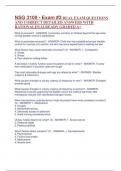
-
NSG 3100 - Exam #3 REAL EXAM QUESTIONS AND CORRECT DETAILED ANSWERS WITH RATIONALES|ALREADY GRADED A+
- Exam (elaborations) • 19 pages • 2023
- Available in package deal
-
- $12.49
- + learn more
NSG 3100 - Exam #3 REAL EXAM QUESTIONS AND CORRECT DETAILED ANSWERS WITH RATIONALES|ALREADY GRADED A+ What is enuresis? - ANSWER- Involuntary urination in children beyond the age when normal bladder control is established What is secondary enuresis? - ANSWER- Child who has established proper bladder control for a period of 6 months, but who has since lapsed back to wetting the bed What factors may cause secondary enuresis? (4) - ANSWER- 1. Constipation 2. Stress 3. Illness 4. Poor ...

-
MCAT Biology and Behavior Exam Questions and Answers
- Exam (elaborations) • 12 pages • 2024
- Available in package deal
-
- $12.49
- + learn more
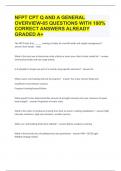
-
NFPT CPT Q AND A GENERAL OVERVIEW-85 QUESTIONS WITH 100% CORRECT ANSWERS
- Exam (elaborations) • 10 pages • 2023
- Available in package deal
-
- $14.99
- + learn more
The NFPT feels that ______ training is better for overall health and eeight management? Slow steady - state What is the best way to determine what sctivity or event your client is best suited for? Overload principle and rep range testing Brainpower Read More Is it possible to target one part of a muscle using specific exercises? No What causes overtraining and lack of progress? Too many sets per body part Insufficient rest between sessions Frequent training beyond ...
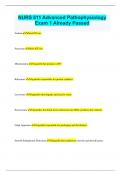
-
NURS 611 Advanced Pathophysiology Exam 1 Already Passed
- Exam (elaborations) • 7 pages • 2023
- Available in package deal
-
- $9.99
- + learn more
NURS 611 Advanced Pathophysiology Exam 1 Already Passed Sodium Main ECF ion. Potassium Main ICF ion. Mitochondria Organelle that produces ATP. Ribosomes Organelles responsible for protein synthesis. Lysosomes Organelles that degrade and recycle waste. Peroxisomes Organelles that break down chemicals into H202, produces free radicals. Golgi Apparatus Organelle responsible for packaging and distribution. Smooth Endoplasmic Reticulum Organelle that synthesizes steroids and detoxification. T...
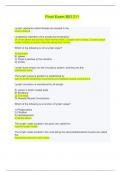
-
Final Exam BIO 211 - Q & A (Complete Solutions)
- Exam (elaborations) • 22 pages • 2024
-
- $19.99
- + learn more
Final Exam BIO 211 - Q & A (Complete Solutions) Lymph capillaries called lacteals are located in the small intestine Lymphatics resemble veins except that lymphatics: all of the above are correct; Have thinner walls, Contain more valves, Contain lymph nodes located at certain intervals along their course Which of the following is not a lymph organ? A) pancreas B) spleen C) Peyer's patches of the intestine D) tonsils Lymph ducts empty into the circulatory system, draining into the: subclavian ...
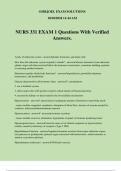
-
NURS 331 EXAM 1 Questions With Verified Answers.
- Exam (elaborations) • 33 pages • 2024
-
- $11.49
- + learn more
NURS 331 EXAM 1 Questions With Verified Answers. 3 parts of endocrine system - answerglands, hormones, and target cells How does the endocrine system respond to stimuli? - answerreleases hormones from endocrine glands; target cells then read and follow the hormone's instructions, sometimes building a protein or releasing another hormone Hormones regulate which body functions? - answerreproduction, growth/development, homeostasis, and metabolism General characteristics all hormones sha...

-
Schwann cell - Glial cells that are located in the peripheral nervous system and that form the myelin sheath around the axon of a neuron. Neruoglial cell - or Glial cells; are non-neuronal cells that maintain homeostasis, form myelin, and provide suppor
- Exam (elaborations) • 14 pages • 2024
-
- $9.49
- + learn more
Intracellular fluid components - 2/3 of the bodies fluid is in the ICF, it's the fluid that is in all of the cells. Extracellular fluid components - the other 1/3 of the total body water, it's made up of interstitial fluid, plasma, lymph, synovial, intestinal, CSF, sweat, urine, pleural, peitoneal, pericardial, and introcular fluid. Where is blood plasma located? - in the extracellular fluid How does fluid move between compartments? - it occurs at the capillary level by forces of pres...
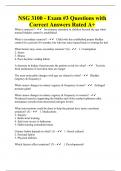
-
NSG 3100 - Exam #3 Questions with Correct Answers Rated A+
- Exam (elaborations) • 22 pages • 2023
-
Available in package deal
-
- $10.99
- + learn more
What is enuresis? - Involuntary urination in children beyond the age when normal bladder control is established What is secondary enuresis? - Child who has established proper bladder control for a period of 6 months, but who has since lapsed back to wetting the bed What factors may cause secondary enuresis? (4) - 1. Constipation 2. Stress 3. Illness 4. Poor daytime voiding habits A decrease in kidney function puts the patient at risk for what? - Toxicity from medication i...

Did you know that on average a seller on Stuvia earns $82 per month selling study resources? Hmm, hint, hint. Discover all about earning on Stuvia


